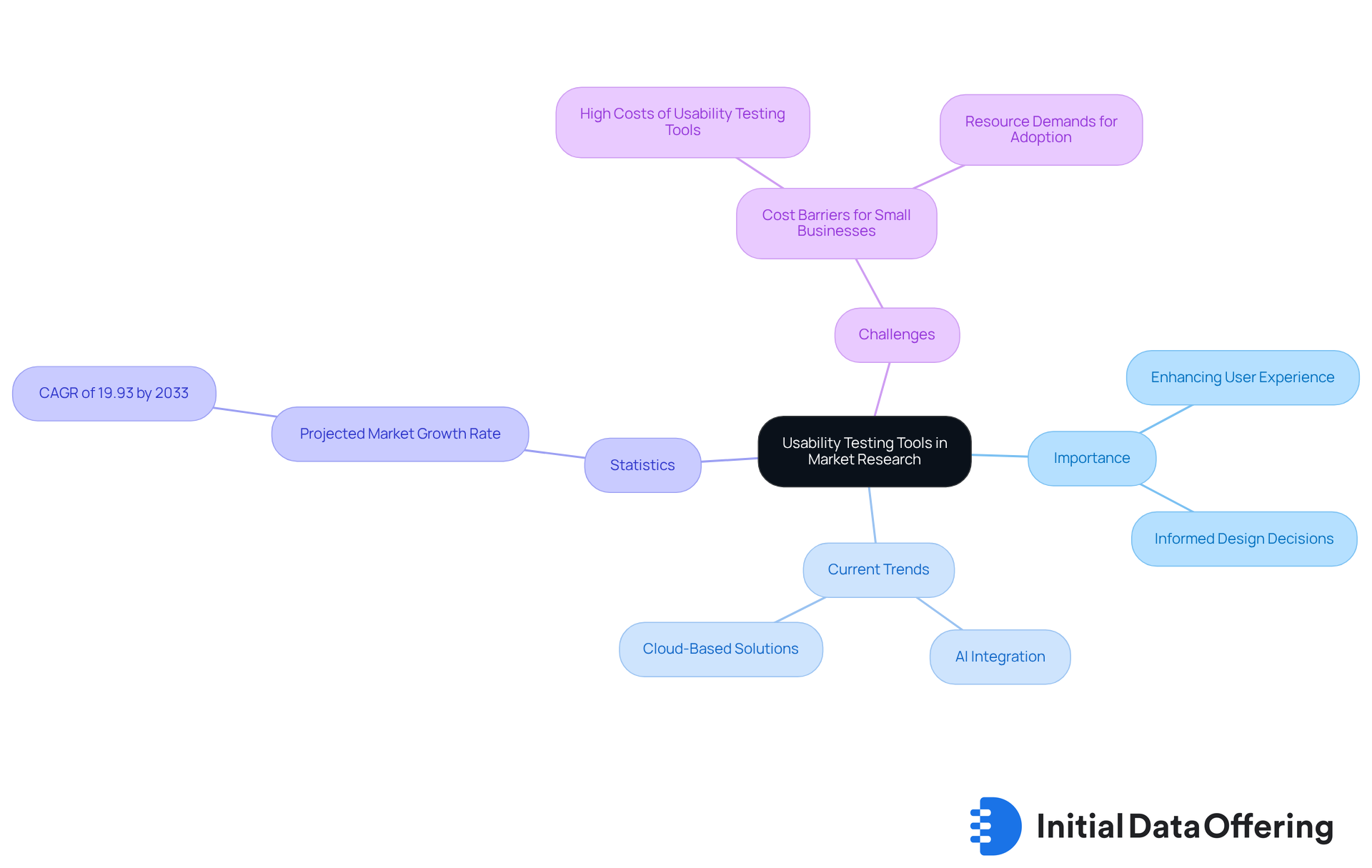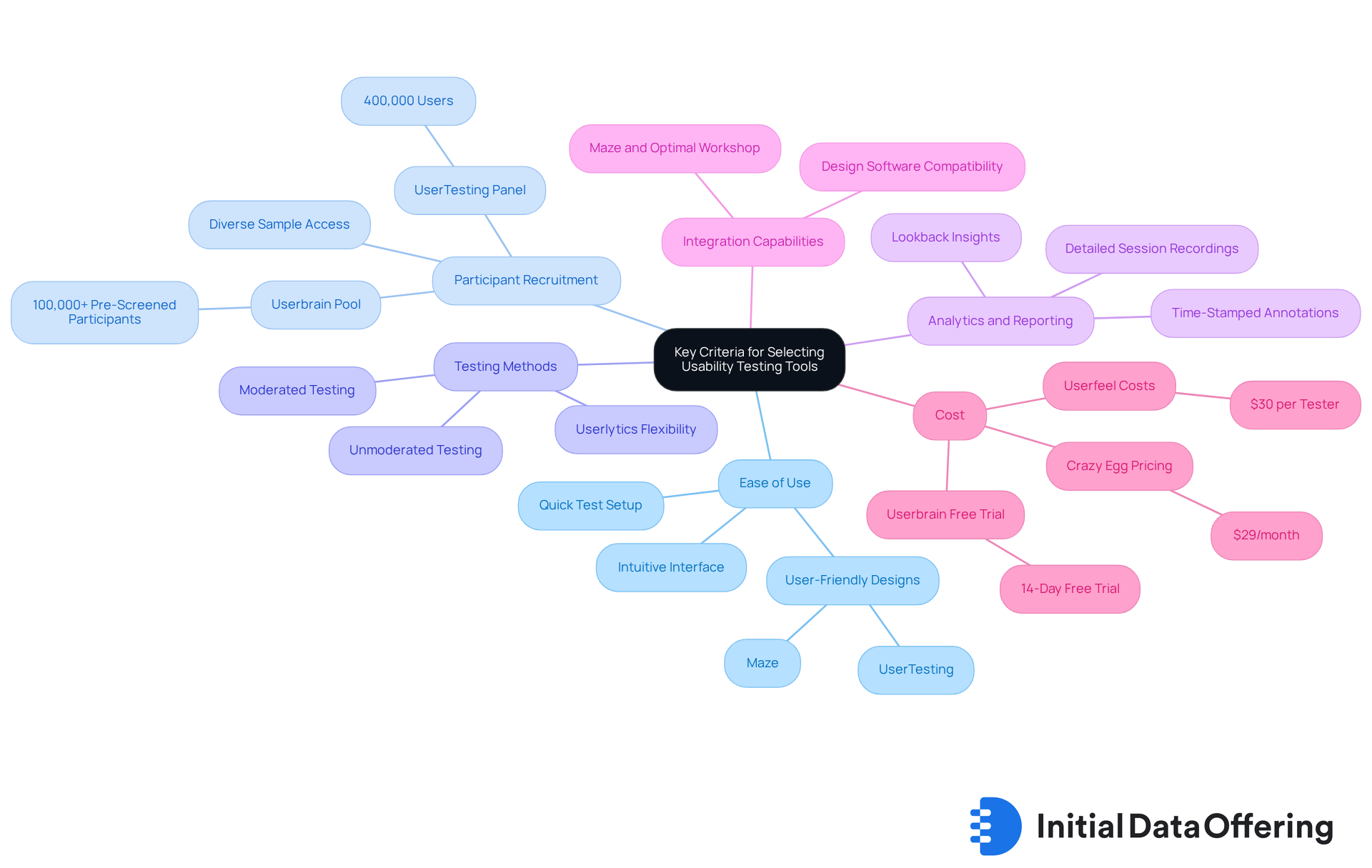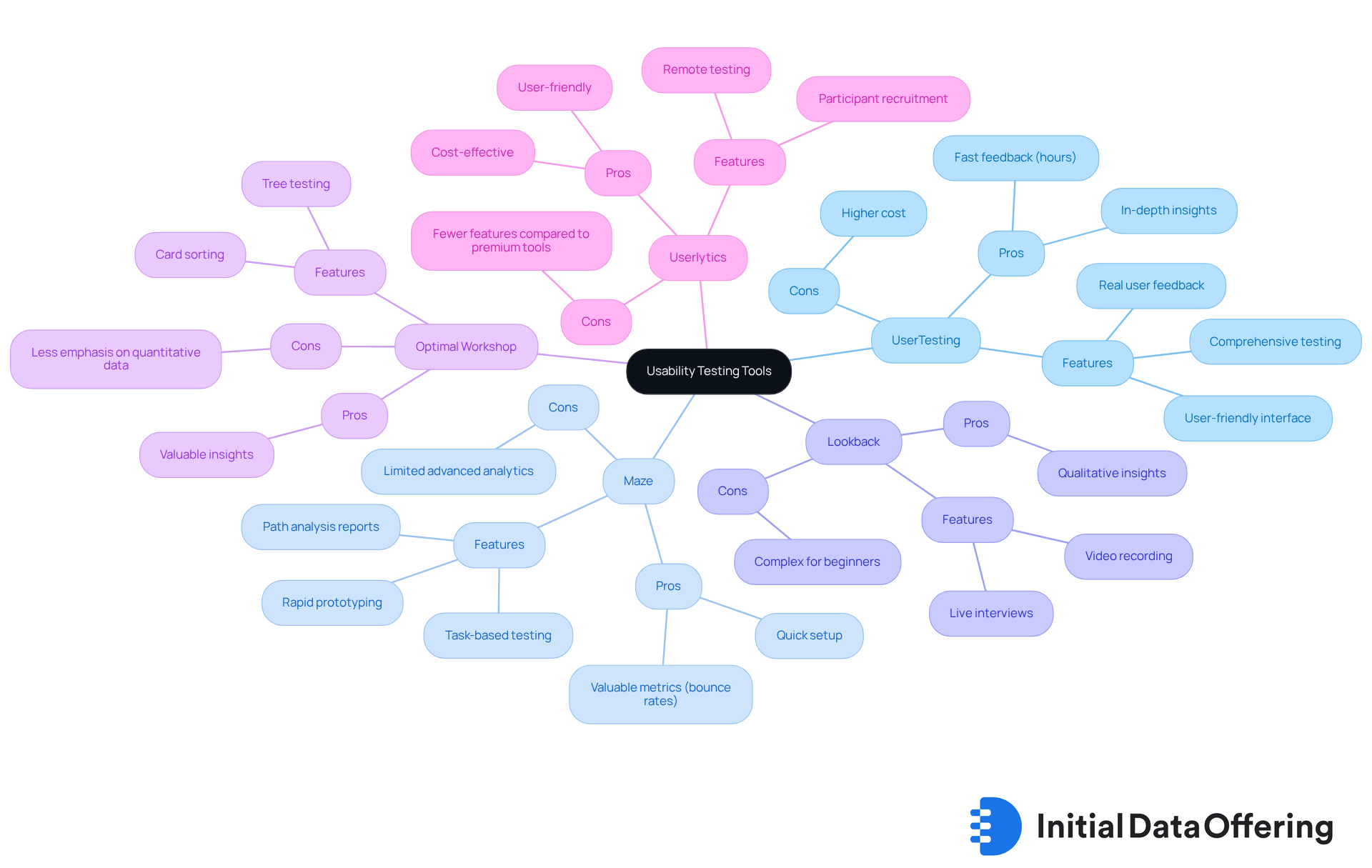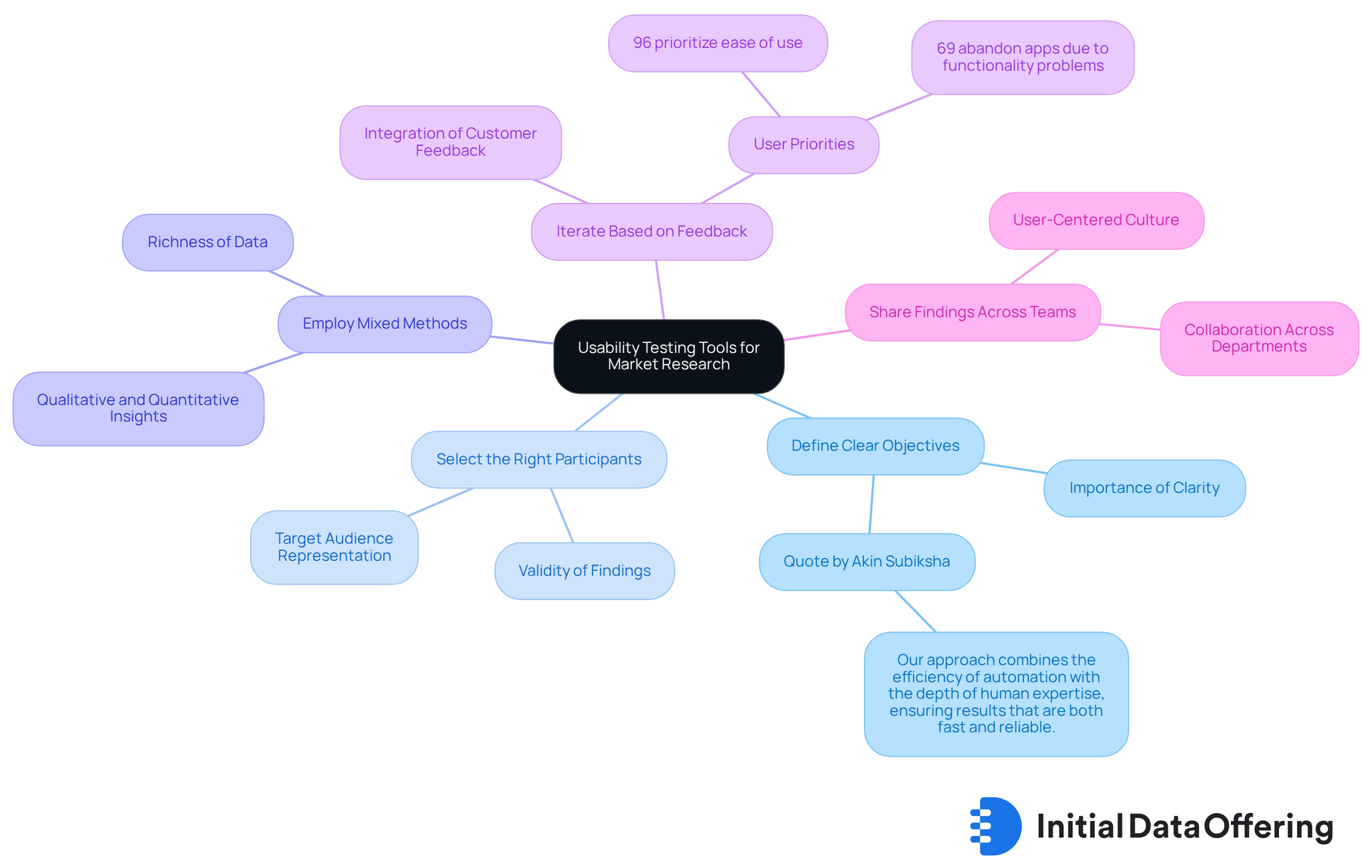4 Usability Testing Tools to Enhance Your Market Research

4 Usability Testing Tools to Enhance Your Market Research
Overview
Usability testing tools serve as essential assets in market research by pinpointing usability issues and collecting user feedback. This process not only enhances product design but also elevates customer satisfaction. Selecting the right tools is crucial; considerations such as:
- Ease of use
- Participant recruitment
- Analytics capabilities
play a significant role in determining the quality and relevance of insights obtained during research. By focusing on these criteria, organizations can ensure that their findings are both actionable and impactful. How can your team leverage these tools to improve user experience and drive design innovation?
Introduction
Usability testing tools have emerged as essential instruments for businesses aiming to enhance their market research efforts. These tools facilitate a deeper understanding of user interactions, identifying usability issues while providing invaluable feedback that can significantly shape product development and marketing strategies.
As the demand for user-friendly solutions continues to grow, organizations face the challenge of selecting the right tool from a crowded market. What key features should researchers prioritize to maximize the benefits of usability testing in their projects? By focusing on these critical elements, businesses can ensure they are equipped to make informed decisions that drive success.
Understanding Usability Testing Tools and Their Importance in Market Research
Usability assessment resources play a vital role in market research, as they facilitate the analysis of interactions with products or services. These usability testing tools are designed to identify usability problems, gather feedback from users, and ultimately enhance the overall user experience. By observing real individuals interacting with a product, researchers can pinpoint pain points and areas for improvement that may not surface through traditional research methods. This process is essential for businesses aiming to refine their offerings and effectively meet customer needs. The insights gained from user evaluations using usability testing tools can inform design decisions, marketing strategies, and product development, making these resources indispensable in the competitive landscape of market analysis.
Current trends indicate a growing demand for user-friendly resources, such as usability testing tools that incorporate artificial intelligence and machine learning, which streamline and enhance user evaluations. Furthermore, the shift towards cloud-based solutions is noteworthy, as these resources offer cost-effectiveness and scalability, particularly beneficial for small and medium-sized enterprises. The market for user experience evaluation resources is projected to grow at a CAGR of 19.93% by 2033, driven by the increasing need for improved digital interactions. This ongoing focus on user-centered design continues to fuel innovation and investment in this sector.
Statistics reveal that companies focusing on functionality assessment can achieve significant improvements in consumer experience, with many reporting enhanced product development outcomes and increased customer satisfaction. However, it is crucial to acknowledge that the high costs associated with usability testing tools can pose a barrier for many small and medium-sized businesses, potentially hindering their ability to adopt these essential solutions. As organizations increasingly prioritize customer satisfaction, the integration of assessment resources is becoming a strategic necessity for success in the digital age.

Key Criteria for Selecting the Right Usability Testing Tool
When selecting usability testing tools, several key criteria must be considered to ensure effective research outcomes.
-
Ease of Use: An intuitive interface is crucial. It allows researchers to set up tests quickly and efficiently. Usability testing tools such as Maze and UserTesting are noted for their user-friendly designs, enabling seamless test creation and management. This ease of use not only saves time but also minimizes the learning curve for new users.
-
Participant Recruitment: Robust participant recruitment options are essential for ensuring a diverse and representative sample. Platforms like UserTesting and Userfeel provide access to vast panels. For instance, UserTesting facilitates recruitment from over 400,000 users, while Userbrain offers a pool of 100,000+ pre-screened participants for prototype evaluation. This diversity improves the reliability of insights obtained, ultimately leading to more informed decisions.
-
Testing Methods: Different resources support various testing methods, including moderated and unmoderated testing. Userlytics, for example, accommodates different usability testing tools, catering to various research needs. This flexibility enhances the quality of insights, allowing researchers to choose the method that best fits their objectives.
-
Analytics and Reporting: Efficient resources should provide extensive analytics and reporting capabilities. Lookback, for example, offers detailed session recordings and time-stamped annotations. This facilitates in-depth analysis and actionable insights. Additionally, usability testing tools like real-time session recording allow researchers to observe user navigation, which is critical for understanding user interactions and behaviors.
-
Integration Capabilities: The ability to connect with other research resources and platforms can significantly improve the evaluation process. Usability testing tools, such as Maze and Optimal Workshop, support integrations with popular design software like Figma, Adobe XD, InVision, and Sketch. This capability streamlines workflows and enhances overall efficiency, making the research process more cohesive.
-
Cost: Budget considerations are crucial; evaluating the pricing structure in relation to the features offered is essential for making a sound investment. For instance, Crazy Egg starts at $29/month, providing valuable insights at a competitive price point. Userfeel costs $30 per tester, while Userbrain offers a 14-day free trial to assess its capabilities before committing. Understanding these costs helps researchers align their budget with their research needs.
By thoughtfully evaluating these standards, researchers can choose the most appropriate assessment instrument to enhance their market research initiatives and achieve better product results. How might these tools transform your usability testing processes?

Comparative Analysis of Leading Usability Testing Tools: Features, Pros, and Cons
This table summarizes the essential features and considerations for each usability testing tool, helping users to identify the most suitable option for their needs. Each usability testing tool offers distinct features that can enhance the usability testing process. For instance, UserTesting provides comprehensive testing and real user feedback, which results in in-depth insights and a user-friendly interface—allowing teams to gather actionable user feedback in hours rather than weeks. However, it is important to note that its cost is higher compared to other options.
Maze, on the other hand, excels in rapid prototyping and task-based testing. Its quick setup makes it ideal for iterative design, and it includes path analysis reports that provide valuable metrics such as bounce rates. Yet, users may find its advanced analytics somewhat limited. Lookback offers live interviews and video recording capabilities, which are excellent for obtaining qualitative insights, although beginners might find it complex to navigate.
Optimal Workshop focuses on card sorting and tree testing, emphasizing information architecture. While it provides valuable insights, it places less emphasis on quantitative data. Lastly, Userlytics supports remote testing and participant recruitment, making it a cost-effective and user-friendly choice, though it has fewer features compared to premium tools.
In total, there are 17 assessment resources available, offering a diverse array for market research analysts to explore. The examination underscores the significance of participant recruitment choices, which are essential for effective user evaluations. Furthermore, the global availability of these resources enables assessments in over 190 nations, providing varied perspectives that can enrich the usability testing tools process.

Applying Usability Testing Tools to Enhance Market Research Outcomes
To maximize the benefits of usability testing tools in market research, organizations should adopt several key strategies.
-
Define Clear Objectives: Establishing precise research objectives is crucial before conducting usability tests. This clarity ensures that the evaluation process remains focused and that relevant data is gathered, ultimately improving the quality of insights. As Akin Subiksha notes, "Our approach combines the efficiency of automation with the depth of human expertise, ensuring results that are both fast and reliable."
-
Select the Right Participants: Choosing participants who accurately represent the target audience is essential. This approach guarantees that the insights collected are applicable and pertinent to the actual audience, thereby enhancing the validity of the findings.
-
Employ Mixed Methods: Merging qualitative and quantitative assessment approaches offers a thorough insight into behavior and preferences. This mixed-methods approach enables researchers to capture both the depth of participant experiences and measurable data, leading to richer insights.
-
Iterate Based on Feedback: Insights gained from user testing should directly inform design iterations. By integrating customer feedback into product development, organizations can create more accessible products that better fulfill client needs. The significance of this is emphasized by the fact that 96% of digital application participants prioritize ease of use, with 69% abandoning apps due to functionality problems.
-
Share Findings Across Teams: Distributing user experience evaluation results among pertinent teams—such as design, marketing, and product development—promotes a user-centered approach throughout the organization. This collaboration ensures that all aspects of the business align with customer needs and preferences. Establishing a culture of user experience within organizations is crucial for the successful implementation of user assessment resources.
By implementing these strategies, organizations can effectively utilize usability testing tools to enhance their market research results. This leads to the development of more user-friendly products and improved customer satisfaction, ultimately strengthening brand loyalty and market competitiveness. The Usability Testing Tools Market is projected to grow from USD 1.51 billion in 2024 to USD 10.41 billion by 2034, highlighting the increasing relevance of these tools in market research.

Conclusion
Usability testing tools are essential in market research, providing invaluable insights that drive product improvement and enhance user experience. By employing these tools, organizations can effectively identify usability challenges, gather meaningful feedback, and make informed decisions that align with customer needs. The integration of advanced technologies and cloud-based solutions further strengthens the role of usability testing tools, making them a strategic component in the competitive landscape of market analysis.
Throughout this article, we have discussed various critical aspects of usability testing tools, including their growing importance, key criteria for selection, and a comparative analysis of leading tools. Factors such as ease of use, participant recruitment capabilities, testing methods, analytics, integration, and cost all play a vital role in determining the right tool for specific research objectives. Additionally, we highlighted the necessity of defining clear objectives, selecting representative participants, and sharing findings across teams to maximize the effectiveness of usability testing.
As the market for usability testing tools continues to expand, with projections indicating significant growth in the coming years, the importance of adopting these tools cannot be overstated. Organizations must embrace the user-centered approach that usability testing fosters to create products that resonate with their audience. By prioritizing usability, companies can enhance customer satisfaction and strengthen their market position. Embracing usability testing tools today is not just an investment in research; it represents a commitment to delivering exceptional user experiences that drive long-term success.
Frequently Asked Questions
What are usability testing tools and why are they important in market research?
Usability testing tools are resources that facilitate the analysis of user interactions with products or services. They are important because they help identify usability problems, gather user feedback, and enhance the overall user experience, which is essential for businesses looking to refine their offerings.
How do usability testing tools benefit businesses?
By observing real users interacting with a product, these tools help researchers identify pain points and areas for improvement that may not be apparent through traditional research methods. The insights gained can inform design decisions, marketing strategies, and product development.
What are current trends in usability testing tools?
There is a growing demand for user-friendly usability testing tools that incorporate artificial intelligence and machine learning. Additionally, the shift towards cloud-based solutions is notable for their cost-effectiveness and scalability, which are particularly beneficial for small and medium-sized enterprises.
What is the projected growth of the market for user experience evaluation resources?
The market for user experience evaluation resources is projected to grow at a compound annual growth rate (CAGR) of 19.93% by 2033, driven by the increasing need for improved digital interactions.
What impact do usability testing tools have on consumer experience?
Companies that focus on functionality assessment using usability testing tools report significant improvements in consumer experience, enhanced product development outcomes, and increased customer satisfaction.
What challenges do small and medium-sized businesses face regarding usability testing tools?
The high costs associated with usability testing tools can be a barrier for many small and medium-sized businesses, potentially hindering their ability to adopt these essential solutions.
Why is integrating usability testing tools becoming a strategic necessity for organizations?
As organizations increasingly prioritize customer satisfaction, integrating usability testing tools is becoming essential for success in the digital age, allowing them to better meet customer needs and enhance user experiences.